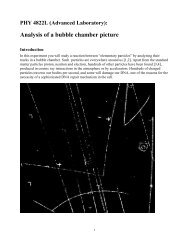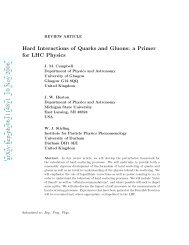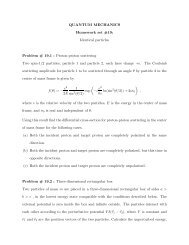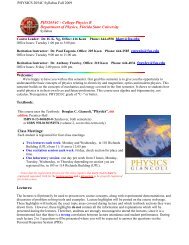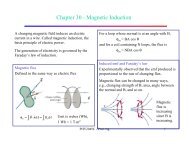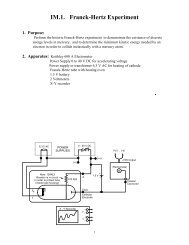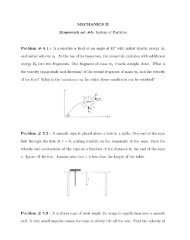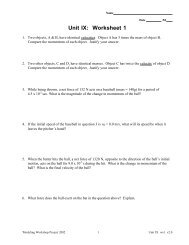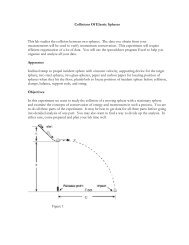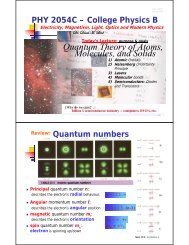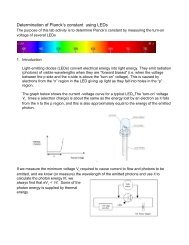Introduction to modern physics - FSU Physics Department
Introduction to modern physics - FSU Physics Department
Introduction to modern physics - FSU Physics Department
You also want an ePaper? Increase the reach of your titles
YUMPU automatically turns print PDFs into web optimized ePapers that Google loves.
<strong>Introduction</strong> <strong>to</strong> <strong>modern</strong> <strong>physics</strong>:<br />
<strong>Physics</strong> of the 20 th and 21 st centuries<br />
<br />
Lectures:<br />
• Quantum <strong>physics</strong><br />
• Nuclear and particle <strong>physics</strong><br />
• some condensed matter <strong>physics</strong><br />
• Relativity – special, general<br />
• Cosmology<br />
Lab experiments: some of the following:<br />
• Earth’s magnetic field<br />
• Geiger Müller counter, half life measurement<br />
• operational amplifier<br />
• mass of the K 0 particle<br />
• e/m of electron<br />
• Franck-Hertz experiment<br />
• Hall effect<br />
• Planck’s constant from LED’s<br />
<br />
Homework problems<br />
problem solving, modeling, simulations<br />
website http://www.<strong>physics</strong>.fsu.edu/courses/Summer13/YSP<br />
1
Quantum <strong>physics</strong><br />
(quantum theory, quantum mechanics)<br />
Part 1:<br />
2
Outline<br />
<strong>Introduction</strong><br />
Problems of classical <strong>physics</strong><br />
emission and absorption spectra<br />
Black-body Radiation<br />
• experimental observations<br />
• Wien’s displacement law<br />
• Stefan – Boltzmann law<br />
• Rayleigh - Jeans<br />
• Wien’s radiation law<br />
• Planck’s radiation law<br />
pho<strong>to</strong>electric effect<br />
• observation<br />
• studies<br />
• Einstein’s s explanation<br />
Summary<br />
3
Question: What do these have in common?<br />
• lasers<br />
• solar cells<br />
• transis<strong>to</strong>rs<br />
• computer chips<br />
• CCDs in digital cameras<br />
• Ipods<br />
• superconduc<strong>to</strong>rs<br />
• .........<br />
Answer:<br />
• They are all based on the quantum <strong>physics</strong><br />
discovered in the 20th century.<br />
4
Why Quantum <strong>Physics</strong>?<br />
“Classical l <strong>Physics</strong>”:<br />
• developed in 15 th <strong>to</strong> 20 th century;<br />
• provides very successful description of “every<br />
day, ordinary objects”<br />
o motion of trains, cars, bullets,….<br />
o orbit of moon, planets<br />
o how an engine works,..<br />
• subfields: mechanics, thermodynamics,<br />
electrodynamics,<br />
• Quantum <strong>Physics</strong>:<br />
o developed early 20 th century, in response <strong>to</strong><br />
shortcomings of classical <strong>physics</strong> in describing certain<br />
phenomena (blackbody radiation, pho<strong>to</strong>electric effect,<br />
emission i and absorption spectra…)<br />
o describes “small” objects (e.g. a<strong>to</strong>ms and their<br />
constituents)<br />
5
“Classical” vs “<strong>modern</strong>” <strong>physics</strong><br />
6
Quantum <strong>Physics</strong><br />
QP is “weird and counterintuitive”<br />
But:<br />
o “Those who are not shocked when they first come<br />
across quantum theory cannot possibly have<br />
unders<strong>to</strong>od it” (Niels Bohr)<br />
o “Nobody feels perfectly comfortable with it “<br />
(Murray Gell-Mann)<br />
o “I can safely say that nobody understands quantum<br />
mechanics” (Richard Feynman)<br />
o QM is the most successful ssfu theory ever developed by<br />
humanity<br />
o underlies our understanding of a<strong>to</strong>ms, molecules,<br />
condensed d matter, nuclei, elementary particles<br />
7<br />
o Crucial ingredient in understanding of stars, …
Features of QP<br />
Quantum <strong>physics</strong> is basically the recognition<br />
that there is less difference between waves<br />
and particles than was thought before<br />
key insights:<br />
o light can behave like a particle<br />
o particles (e.g. electrons) are indistinguishable<br />
i i o particles can behave like waves (or wave<br />
packets)<br />
o waves gain or lose energy only in "quantized<br />
amounts“<br />
o detection (measurement) of a particle<br />
wave will change suddenly in<strong>to</strong> a new wave<br />
o quantum mechanical interference – amplitudes<br />
add<br />
o QP is intrinsically probabilistic<br />
o what you can measure is what you can know<br />
8
emission spectra<br />
continuous spectrum<br />
o solid, liquid, or dense gas emits continuous<br />
spectrum of electromagnetic radiation<br />
(“thermal radiation”);<br />
o <strong>to</strong>tal intensity and frequency dependence<br />
of intensity change with temperature<br />
(Kirchhoff, Bunsen, Wien, Stefan,<br />
Boltzmann, Planck)<br />
line spectrum<br />
o rarefied gas which is “excited” by heating,<br />
or by passing discharge through it, emits<br />
radiation consisting of discrete wavelengths<br />
(“line spectrum”)<br />
o wavelengths of spectral lines are<br />
characteristic of a<strong>to</strong>ms<br />
9
Emission spectra:<br />
11
Absorption spectra<br />
• first seen by Fraunhofer in light from Sun;<br />
• spectra of light from stars are absorption<br />
spectra (light emitted by hotter parts of<br />
star further inside passes through colder<br />
“atmosphere” of star)<br />
• dark lines in absorption spectra match<br />
bright lines in discrete emission spectra<br />
• Helium discovered by studying Sun's<br />
spectrum<br />
• light from continuous-spectrum source<br />
passes through colder rarefied gas before<br />
reaching observer;<br />
12
Fraunhofer spectra<br />
13
Spectroscopic studies<br />
14
Kinetic theory of heat<br />
Molecules are in constant random motion,<br />
Average kinetic energy depends only on temperature<br />
In thermal equilibrium, energy is equally shared<br />
between all “degrees of freedom” of the possible<br />
motions, ons, ave. kinetic energy per degree of freedom<br />
=<br />
= ½k B T (k B = Boltzmann’s constant)<br />
Degrees of freedom: translational motion in 3<br />
dimensions i has 3 degrees of freedom (dof);<br />
Rotational and vibrational motion: nb. of dof depends<br />
on number of a<strong>to</strong>ms and their configuration in<br />
molecule<br />
15
0th law of thermodynamics<br />
• between bodies of different temperature (i.e. of different<br />
average internal thermal energy), heat will flow from the<br />
body of higher temperature <strong>to</strong> the body of lower<br />
temperature until the temperatures of the two bodies are<br />
the same;<br />
• then the bodies are in “thermal equilibrium”<br />
• two bodies are in thermal equilibrium (at same temperature)<br />
if there is no heat flow between them;<br />
• corollary: if two bodies are in thermal equilibrium with a<br />
third body, then they are in thermal equilibrium with each<br />
other.<br />
• can use thermometer <strong>to</strong> compare temperature<br />
• note:<br />
o observation only shows that temperatures equalize -<br />
heat flow is hypothesis<br />
16
temperature<br />
Temperature:<br />
• was measured long before it was unders<strong>to</strong>od;<br />
• Galilei (around 1592): “device <strong>to</strong> measure degree of<br />
hotness”; inverted narrow-necked flask, warmed in<br />
hand, put upside down in<strong>to</strong> liquid; liquid level<br />
indicates temperature; OK, but not calibrated.<br />
• Hooke, Huygens, Boyle (1665): “fixed points” -<br />
freezing or boiling point of water;<br />
• C. Renaldini (1694): use both freezing and boiling<br />
point<br />
• Modern point of view: temperature is measure of<br />
kinetic energy of random motion of molecules,<br />
a<strong>to</strong>ms,..<br />
• http://en.wikipedia.org/wiki/Temperature<br />
ped / emperature<br />
• http://hyper<strong>physics</strong>.phy-astr.gsu.edu/hbase/thermo/temper.html<br />
• http://eo.ucar.edu/skymath/tmp2.html<br />
• http://www.visionlearning.com/library/module_viewer.php?mid=48<br />
17
Thermal energy, heat, temperature<br />
observation of ”Brownian motion” ” (1827):<br />
• small seeds (e.g. burlap) suspended in liquid show erratic<br />
motion (“random motion”)<br />
• http://galileo.phys.virginia.edu/classes/109N/more_stuff/Applets/brownian/brownian.html<br />
h i i i / l ss s/109N/m st l ts/b i /b i html<br />
• http://www.aip.org/his<strong>to</strong>ry/einstein/brownian.htm<br />
kinetic theory of heat (Boltzmann, Maxwell,...)<br />
• heat is a form of energy;<br />
• internal energy = thermal energy of material bodies is<br />
related <strong>to</strong> random motions of molecules or a<strong>to</strong>ms<br />
• temperature is a measure of this internal energy .<br />
• explanation of Brownian motion: Albert Einstein (1905):<br />
calculated speed of “diffusion” from kinetic theory of<br />
heat - found in agreement with experimental<br />
measurements<br />
• strong support for a<strong>to</strong>mic picture of matter<br />
• http://en.wikipedia.org/wiki/Theory //en.wikipedia.org/wiki/Theory_of_hea<strong>to</strong>f heat<br />
• http://en.wikipedia.org/wiki/Kinetic_theory<br />
• http://www.vias.org/<strong>physics</strong>/bk2_03_02.html<br />
• http://www.youtube.com/watch?v=-n90pfbiBJE<br />
• http://galileo.phys.virginia.edu/classes/252/kinetic_theory.html<br />
18
Fahrenheit, Celsius scale<br />
Fahrenheit scale:<br />
• Gabriel Daniel Fahrenheit (Danzig, 1686-1736),<br />
glassblower and physicist;<br />
o reproducible thermometer using mercury (liquid<br />
throughout range) (around 1715)<br />
o 0 point: lowest temperature of winter of 1709, (using mix<br />
of water, ice, salt −17.8 8 °C )<br />
o 96 o = body temperature (96 divisible by 12, 8),<br />
o water freezes at 32 o F, boils at 212 o F<br />
o<br />
http://inven<strong>to</strong>rs.about.com/od/tstartinventions/a/His<strong>to</strong>ry-Of-The-Thermometer.htmnt t tin nti ns/ /Hist m m t htm<br />
Celsius scale:<br />
• Anders Celsius (Swedish astronomer, 1701 - 1744)<br />
• 0 o C = ice point (mixture of water and ice at 1 atm)<br />
• 100 o C = boiling point of water at 1 atm. (1742)<br />
relation between Fahrenheit and Celsius degrees:<br />
• T C<br />
= (5/9)(T F<br />
- 32 ) , T F<br />
= (9/5)T C<br />
+ 32<br />
19
Temperature (2)<br />
thermodynamic temperature scale<br />
• (absolute, Kelvin scale)<br />
• pressure vs temperature t of gas at constant t volume<br />
and volume vs temperature of gas at constant<br />
pressure extrapolate <strong>to</strong> zero at - 273.15 o C<br />
• this is “absolute zero”<br />
• unit: Kelvin<br />
• Size of unit of Kelvin scale = that of Celsius scale,<br />
only shift of zero-point<br />
• This is the temperature scale which is used in most of<br />
<strong>physics</strong><br />
• http://en.wikipedia.org/wiki/Kelvin<br />
• http://abyss.uoregon.edu/~js/glossary/temperature_scale.html<br />
edu/~js/glossary/temperature scale html<br />
• http://lamar.colostate.edu/~hillger/temps.htm<br />
20
Range of temperatures<br />
• Universe 5×10 −44 s after the Big Bang: T 1.4×10 32 K<br />
• core of hottest stars, 410 9 K; seems maximum now<br />
• hydrogen bomb ignites at , 410 7 K;<br />
• interior of Sun , 1.510 6 K;<br />
• plasma 10 5 K;<br />
• 10 5 K : clouds of a<strong>to</strong>ms, ions, e, occasional molecule;<br />
• 5800 K: surface of the Sun; 5000 K: cool spots at surface of the<br />
Sun; evidence for some molecules;<br />
• 3000 K: water steam: about 1/4 of water molecules ruptured in<strong>to</strong><br />
a<strong>to</strong>ms;<br />
• 2800 K: W light bulb filament;<br />
• 2000 K: molten lava;<br />
• 1520 o C: iron melts; 327 o C: lead melts;<br />
• 100 o C (373.15 K): water boils;<br />
• 252 K (-21.1 o C = 5.8 o F): temp. of salt-ice saltwater mix;<br />
• 234 K: mercury freezes; 194 K: dry ice freezes;<br />
• 77 K: nitrogen boils<br />
• 4 K: helium boils.<br />
• ;<br />
22
Thermal radiation<br />
<br />
<br />
<br />
<br />
<br />
thermal radiation = e.m. radiation emitted by a body by virtue<br />
of its temperature<br />
spectrum is continuous, comprising all wavelengths<br />
thermal radiation formed inside body by random thermal<br />
motions of its a<strong>to</strong>ms and molecules, repeatedly absorbed and<br />
re-emitted on its way <strong>to</strong> surface original character of<br />
radiation obliterated spectrum of radiation depends only on<br />
temperature, not on identity of object<br />
amount of radiation actually emitted or absorbed depends on<br />
nature of surface<br />
good absorbers are also good emitters (why??)<br />
• http://hyper<strong>physics</strong>.phy-astr.gsu.edu/hbase/thermo/absrad.html<br />
html<br />
• http://casswww.ucsd.edu/archive/public/tu<strong>to</strong>rial/Planck.html<br />
• http://panda.unm.edu/Courses/Finley/P262/ThermalRad/ThermalRad.html<br />
• http://csep10.phys.utk.edu/astr162/lect/light/radiation.html<br />
• http://www.youtube.com/watch?v=CDncSyDvpdQ<br />
• http://www.enotes.com/<strong>to</strong>pic/Kirchhoff's_law_of_thermal_radiation<br />
• http://ip.anndannenberg.com/IPHandouts/Heattransfernotes.pdf<br />
23
warm bodies emit radiation<br />
24
Black-body radiation<br />
“Black body”<br />
• perfect absorber<br />
o ideal body which absorbs all e.m. radiation that<br />
strikes it, any wavelength, any intensity<br />
o such a body would appear black “black<br />
body”<br />
• must also be perfect emitter<br />
o able <strong>to</strong> emit radiation of any wavelength at any<br />
intensity i -- “black-body b radiation”<br />
i “Hollow cavity” (“Hohlraum”) kept at<br />
constant T<br />
o hollow cavity with small hole in wall is good<br />
approximation <strong>to</strong> black body<br />
o thermal equilibrium inside, radiation can escape<br />
through hole, looks like black-body radiation<br />
25
Studies of radiation from hollow cavity<br />
In 2 nd half of 19 th century,<br />
behavior of radiation within a<br />
heated cavity studied d by many<br />
physicists, both theoretically<br />
and experimentally<br />
Experimental findings:<br />
• spectral density ρ(f,T)<br />
(= energy per unit volume<br />
per unit frequency) of the<br />
heated cavity depends on<br />
the frequency f of the<br />
emitted light and the<br />
temperature T of the cavity<br />
and nothing else.<br />
26
Thermal radiation<br />
“Global description”, i.e without frequency dependence:<br />
• Descriptions successful, i.e. in agreement with observations<br />
<strong>to</strong>tal power output of black body: Stefan-Boltzmann law:<br />
• For an “ideal” radia<strong>to</strong>r (“black body”)<br />
),<br />
<strong>to</strong>tal emitted power (per unit emitting area), P/A<br />
P/A = σ·T 4 σ = 5.672 · 10 -8 W m -2 K -4<br />
(Josef Stefan, Ludwig Boltzmann 1879, 1884)<br />
• http://csep10.phys.utk.edu/astr162/lect/light/radiation.htmlphys edu/astr162/lect/light/radiation html<br />
http://hyper<strong>physics</strong>.phy-astr.gsu.edu/hbase/thermo/stefan.html<br />
http://scienceworld.wolfram.com/<strong>physics</strong>/Stefan-BoltzmannLaw.html<br />
Wien’s displacement law (1893)<br />
peak vs temperature:<br />
max ·T = C, C= 2.898 · 10 -3 mK<br />
inverse relationship between the wavelength of the peak of the<br />
emission i of a black body and its temperature when expressed as<br />
a function of wavelength<br />
• http://en.wikipedia.org/wiki/Wien's_displacement_law hyper<strong>physics</strong>.phy-<br />
astr.gsu.edu/hbase/quantum/wien2.html<br />
html<br />
http://scienceworld.wolfram.com/<strong>physics</strong>/WiensDisplacementLaw.html<br />
http://web<strong>physics</strong>.davidson.edu/faculty/dmb/blackbody/Wiendemo.html<br />
27
Intensity vs frequency<br />
Wilhelm Wien (1896)<br />
(f, T) = af 3 exp(-bf/T) bf/T),<br />
(a and b constants).<br />
• OK for high frequency but fails for low frequencies<br />
• http://en.wikipedia.org/wiki/Wien_approximation<br />
http://theochem.kuchem.kyo<strong>to</strong>-u.ac.jp/Ando/planck1901.pdf<br />
m p p http://bado-shanai.net/map%20of%20<strong>physics</strong>/mopWienslaws.htm<br />
http://<strong>physics</strong>.info/planck/<br />
Rayleigh-Jeans Law (1900)<br />
(f,T) = af 2 T (a = constant)<br />
• (constant found <strong>to</strong> be = 8k/c<br />
3 by James Jeans, in 1906)<br />
• OK for low frequencies, but “ultra – violet catastrophe” t at high h<br />
frequencies, i.e. intensity grows f 2 for f <br />
(corresponding <strong>to</strong> limit of wavelength 0)<br />
• http://hyper<strong>physics</strong>.phy-astr.gsu.edu/hbase/quantum/rayj.html http://hyper<strong>physics</strong>.phyastr.gsu.edu/hbase/mod6.html<br />
http://scienceworld.wolfram.com/<strong>physics</strong>/Rayleigh-JeansLaw.html<br />
28
Ultraviolet catastrophe<br />
(Rayleigh-Jeans)<br />
29
Planck’s quantum hypothesis<br />
Max Planck (Oct 1900) found formula that<br />
reproduced the experimental results<br />
2<br />
8<br />
f<br />
( f, T) E<br />
3 osc<br />
<br />
c<br />
hf<br />
<br />
Eosc<br />
<br />
hf / kT<br />
e 1<br />
is the average<br />
energy of a cavity<br />
“oscilla<strong>to</strong>r”<br />
derivation from classical thermodynamics, but<br />
required assumption that oscilla<strong>to</strong>r energies can<br />
only take specific values E = 0, hf, 2hf, 3hf, …<br />
for a multi-state system of particles in thermal<br />
equilibrium, probability for particle <strong>to</strong> be in state<br />
with energy E,<br />
P(E) = (1/Z)e -E/kT (“Boltzmann fac<strong>to</strong>r” )<br />
31
Black-body radiation spectrum<br />
Measurements of<br />
Lummer and Pringsheim<br />
(1900)<br />
calculation<br />
schematisch<br />
32
Consequences of Planck’s hypothesis<br />
oscilla<strong>to</strong>r energies E = nhf, n = 0,1,…;<br />
• h = 6.626626 10 -34<br />
Js = 4.13 10 -15 eV·s<br />
now called Planck’s constant<br />
• oscilla<strong>to</strong>r’s s energy can only change by<br />
discrete amounts, absorb or emit energy<br />
in small packets –“quanta”;<br />
E quantum = hf<br />
• average energy of oscilla<strong>to</strong>r<br />
= hf/(e x – 1) with x = hf/kT;<br />
for low frequencies get classical result<br />
= kT, k = 1.38 · 10 -23 J·K -1<br />
33
Frequencies in cavity radiation<br />
cavity radiation = system of standing waves produced by<br />
interference of e.m. waves reflected between cavity walls<br />
<br />
many more “modes” per wavelength band <br />
at high frequencies (short wavelengths)<br />
than at low frequencies<br />
• for cavity of volume V, n = (8πV/ 4 ) <br />
or n = (8πV/c 3 ) f 2 f<br />
if energy continuous, get equipartition, = kT all modes<br />
have same energy spectral density grows beyond bounds as<br />
f<br />
If energy related <strong>to</strong> frequency and not continous (E = nhf),<br />
the “Boltzmann fac<strong>to</strong>r” e<br />
-E/kT<br />
leads <strong>to</strong> a suppression of high<br />
frequencies<br />
34
Problems<br />
estimate Sun’s surface temperature assuming:<br />
• Earth and Sun are black bodies<br />
• Stefan-Boltzmann law<br />
• Earth in energetic equilibrium<br />
(i.e. rad. power absorbed b = rad. power<br />
emitted) , mean temperature T = 290K<br />
• Sun’s angular size Sun = 32’<br />
show that for small frequencies, Planck’s average<br />
oscilla<strong>to</strong>r energy yields classical equipartition result<br />
= kT<br />
show that for standing waves on a string, number of<br />
waves in band between and + is n = (2L/ 2 ) <br />
35
Summary<br />
<br />
classical <strong>physics</strong> explanation of black-body<br />
radiation failed<br />
Planck’s ad-hoc assumption of “energy quanta”<br />
of energy E quantum = h, modifying Wien’s radiation<br />
law, leads <strong>to</strong> a radiation spectrum which agrees with<br />
experiment.<br />
old generally accepted principle p of “natura non facit<br />
saltus” violated<br />
<br />
Opens path <strong>to</strong> further developments<br />
36



